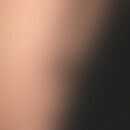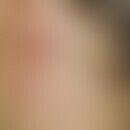DefinitionThis section has been translated automatically.
The active laser media of the dye laser (pulsed and tunable) are large dye molecules dissolved in a suitable liquid. These laser types emit a broad, continuous spectral range between 380 and 1000 nm. The desired emission range can be tuned in 50 nm steps (tunable laser technology). The absorption bands for haemoglobin are in the wavelength range between 577 and 585 nm. In this respect, the response is particularly good for bright red vascular lesions.
Notice!
Dye laser therapy is the gold standard in the treatment of Naevi flammei.Notice! The devices are technically complex. High acquisition costs!
General informationThis section has been translated automatically.
- Flashlamp-pumped pulsed dye lasers (577-600 nm, 200-1500 μs or up to 40 ms; preferred absorption in oxyhemoglobin) are particularly suitable for photothermolysis of superficial vascular neoplasms or malformations. It is superior to other procedures, especially for naevi flammei and the like, in children, but also in adults.
- Shorter pulse times 200-450 μs are mainly used for thin vessels (< 200 μm), longer pulse times (1.5-40 ms) are suitable for stronger vessels. Initially a test treatment is useful.
- Surface anaesthesia with local anaesthetics such as EMLA cream or cooling are favourable. After the treatment light protection (sun protection) for 6-8 weeks. See below for light protection.
You might also be interested in
IndicationThis section has been translated automatically.
Pigment anomalies, naevus flammeus (especially light-coloured naevi flammei in early years), initial haemangiomas, verrucae vulgares, keloids.
Undesirable effectsThis section has been translated automatically.
After the treatment a purpura appears. Occasionally hyperpigmentation occurs, more rarely hypopigmentation. Rarely occurrence of atrophic scars.
LiteratureThis section has been translated automatically.
- Ercocen AR et al (2003) Efficacy of the flashlamp-pumped pulsed-dye laser in nonsurgical delay of skin flaps. Dermatol Surgery 29: 692-699
- Kopera D (2002) Verrucae vulgares. Treatment with 585 nm flashlamp pumped pulsed dye laser. dermatologist 53: 604-607
- Lorenz S, Scherer K et al (2003) Variable pulse frequency-doubled Nd:YAG laser versus flashlamp-pumped pulsed dye laser in the treatment of port wine stains. Acta Derm Venereol 83: 210-213
- Manuskiatti W et al (2001) Energy density and numbers of treatment affect response of keloidal and hypertrophic sternotomy scars to the 585-nm flashlamp-pumped pulsed-dye laser. J Am Acad Dermatol 45: 557-565
- Scherer K et al (2001) Both the flashlamp-pumped dye laser and the long-pulsed tunable dye laser can improve results in port-wine stain therapy. Br J Dermatol 145: 79-84




